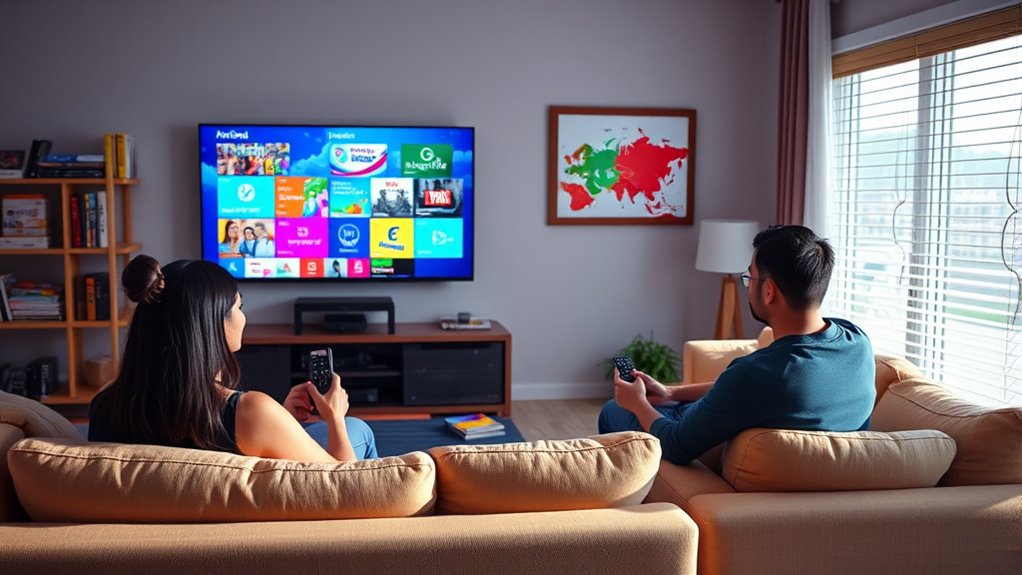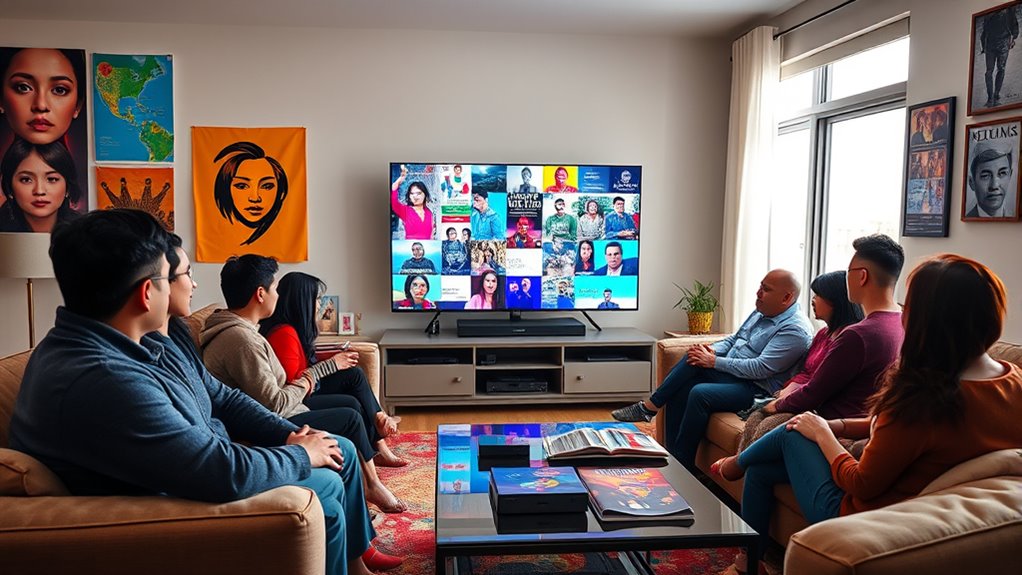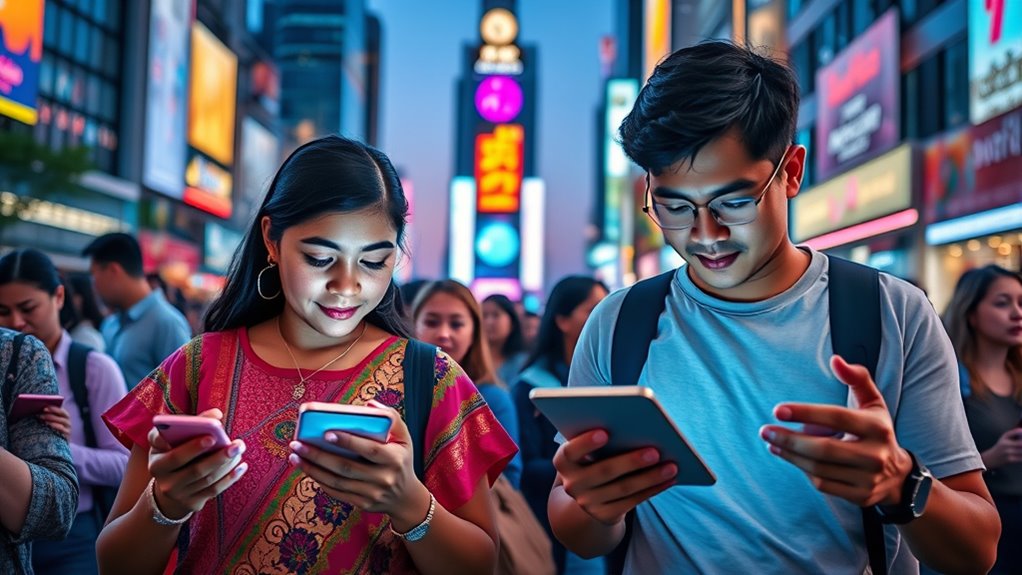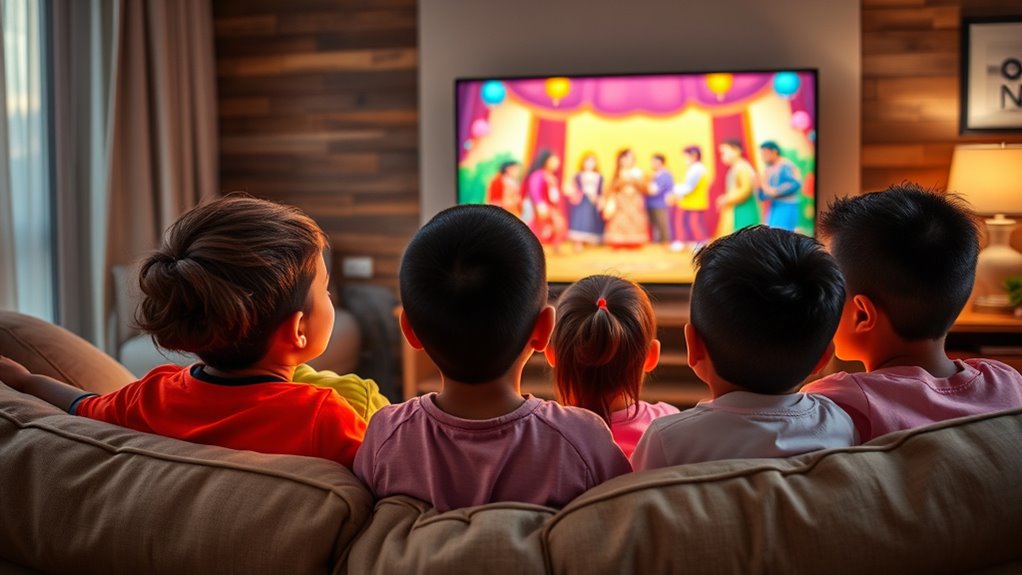International content is increasingly shaping how Hispanic and Asian viewers choose what to watch, reflecting their cultures, languages, and identities. Hispanic audiences favor Spanish-language shows and Latin-themed content that build community and connection. Asians seek multicultural series and niche genres that mirror their backgrounds. Different device preferences and localization strategies drive engagement further. If you want to discover how these trends influence popular shows and streaming strategies, keep exploring the full story.
Key Takeaways
- International content enhances cultural connection, increasing engagement and loyalty among Hispanic and Asian viewers by reflecting their heritage and languages.
- Spanish-language programming drives subscription growth and platform preference among Hispanic audiences, boosting viewership of culturally relevant shows.
- Asian viewers explore international and niche genres more frequently, favoring on-demand, multi-device, and time-shifted content consumption.
- Localization strategies like subtitles and dubbing make international shows more accessible, fostering deeper cross-cultural understanding and engagement.
- Investment in culturally specific programming and marketing broadens international content’s appeal, promoting diversity and shaping multicultural viewing habits.
Growing Preferences for International Content Among Hispanic Viewers

As streaming platforms expand their international content libraries, Hispanic viewers are increasingly showing a preference for diverse, culturally resonant programming. You’re more likely to seek out shows and movies that reflect your heritage or introduce you to new cultural perspectives. This shift is driven by the availability of Spanish-language content and Latine-themed programming that resonates on a personal level. You want access to authentic stories, whether it’s a telenovela, a Latinx comedy, or international dramas that highlight shared experiences. Streaming services cater to this demand by offering a broader range of Spanish and Latin American content, making it easier for you to find entertainment that feels familiar or expands your cultural horizons. This trend underscores your desire for representation and connection through media. Additionally, the increasing presence of cultural diversity in media helps foster a sense of community and understanding among viewers from different backgrounds.
Impact of Spanish-Language Programming on Streaming Trends in Hispanic Households

Spanish-language programming has become a key driver in shaping streaming trends within Hispanic households. You notice that more viewers prefer platforms offering diverse Spanish content, which influences their subscription choices. Streaming services have expanded Spanish-language libraries, making it easier to access culturally relevant shows and movies. This growth encourages cord-cutting, as many Hispanic households favor free, ad-supported options or short-term subscriptions to targeted Spanish content. The availability of Spanish programming enhances viewer engagement, with many watching over two hours weekly. Additionally, the rise of Ice Cream Consumption trends demonstrates how consumer preferences can shift based on cultural influences, further emphasizing the importance of tailored content. As a result, streaming platforms now prioritize Spanish-language offerings to attract and retain Hispanic audiences. This shift not only reflects their content preferences but also drives broader changes in how Hispanic households consume media.
Asian Americans’ Shift Toward Global and Multicultural Content Consumption

Growing interest in international and multicultural content among Asian American viewers reflects broader shifts in media consumption patterns. You’re increasingly exploring diverse genres and shows from different countries, often on digital platforms that make access easier. Asian Americans favor multi-device, time-shifted viewing, allowing flexibility to watch international content whenever it fits into your schedule. Streaming services tailor their libraries to include a wide array of multicultural offerings, which attracts your attention and keeps you engaged. Your preferences are shifting away from traditional TV, with a focus on online videos and international series that resonate culturally or linguistically. This trend highlights your desire for content that reflects your multicultural identity, broadens your cultural understanding, and fits your on-demand, mobile lifestyle. Additionally, the high refresh rates of modern projectors enable smoother playback of fast-paced international sports and action scenes, enhancing your viewing experience. Overall, your viewing habits are becoming more global and multicultural, shaping the future of media consumption.
Differences in Device Usage and Content Engagement Between Hispanic and Asian Audiences

Hispanic and Asian audiences differ considerably in how they use devices and engage with content. You’ll find that Hispanics mainly rely on streaming platforms through connected TVs and mobile devices, often favoring free, ad-supported options and short-term subscriptions. They spend more hours weekly on streaming, especially for culturally resonant programming and sports. Asian audiences, on the other hand, tend to diversify their device use, frequently engaging on multiple devices like tablets, smartphones, and computers. They prefer time-shifted, on-demand viewing and show increasing interest in online videos, especially on social media platforms like TikTok and Instagram. While Hispanics lean toward traditional streaming with a focus on culturally relevant content, Asian viewers actively explore international and multicultural content across various digital platforms, reflecting their diverse content preferences and device habits. Additionally, content engagement varies significantly, with Asians more likely to explore niche and international genres, further emphasizing their broad interests and device versatility.
Cultural Relevance and Localization: Key Drivers for International Content Popularity

Cultural relevance and localization are essential factors driving the popularity of international content among diverse audiences. When content reflects your language, traditions, and cultural nuances, it resonates more deeply, increasing engagement. Streaming platforms that adapt their offerings to fit your cultural context see higher viewership and loyalty. This includes providing subtitles, dubbing, and culturally specific themes that connect with your experiences.
You’re more likely to watch shows that reflect your heritage and speak your language. Localization helps break down barriers, making international content feel familiar and accessible. Streaming services that prioritize cultural relevance and tailor content to your preferences foster stronger connections and generate ongoing interest. Additionally, understanding drivetrain components can enhance the overall viewing experience by ensuring smooth and reliable access to content.
Future Trends: International Content’s Role in Shaping Multicultural Viewing Habits

As the demand for diverse and localized content grows, international programming will increasingly shape multicultural viewing habits. You’ll see more cross-cultural engagement as streaming platforms expand content tailored to various audiences. This trend will likely redefine how audiences from different backgrounds discover and connect with international stories. Additionally, the incorporation of cultural elements into programming will foster a deeper understanding and appreciation of different traditions and lifestyles.
Growing Demand for Diversity
As streaming platforms expand their international content libraries, viewers are increasingly seeking diverse programming that reflects a variety of cultures and languages. You want content that resonates with your background, interests, and identity. This growing demand pushes providers to offer more multicultural options, from Spanish-language dramas to Asian cinema. You’re looking for authenticity and representation, shaping your viewing choices.
Some key trends include:
- Increased availability of culturally specific shows and movies tailored to Hispanic and Asian audiences.
- A rise in bilingual and subtitled content, making diverse stories more accessible.
- A preference for shows that explore cultural traditions, social issues, and personal stories, fostering a sense of connection and inclusion.
Content Localization Trends
Emerging content localization trends are transforming how multicultural audiences access and engage with international programming. Streaming services increasingly tailor content through subtitles, dubbing, and culturally relevant adaptations, making international shows more accessible and appealing. You’ll notice a surge in Spanish- and Asian-language content, often customized to reflect regional dialects, humor, and cultural nuances. These efforts help bridge language barriers and foster a deeper connection with viewers. Platforms are investing in localized marketing and culturally specific programming to attract diverse audiences. As a result, you’re more likely to find international content that resonates with your cultural background and preferences. This trend not only broadens viewing options but also elevates international shows’ presence in mainstream media, shaping how you consume multicultural entertainment.
Cross-Cultural Engagement Rise
International content is increasingly shaping how multicultural audiences explore and connect with media across borders. You’re more likely to watch shows and movies that blend cultural influences, fostering a sense of shared identity. This rise in cross-cultural engagement encourages viewers to discover new traditions, languages, and stories, breaking down cultural barriers. Additionally, the popularity of specialized products like eye patches reflects a broader trend of embracing diverse beauty and self-care routines worldwide. This trend promotes multicultural understanding and influences your viewing choices, making international stories a crucial part of your media experience. It’s shaping a more connected, global entertainment landscape.
Frequently Asked Questions
How Do International Content Preferences Vary Across Different Hispanic and Asian Age Groups?
You’ll find that younger Hispanic and Asian viewers prefer international content more than older age groups. Younger Hispanics and Asians often seek diverse languages and cultural themes, especially on streaming platforms. Older audiences tend to stick with traditional or domestic content. As a result, you’ll notice that age influences how much international content they consume, with younger viewers actively exploring global shows, movies, and cultural stories across digital and streaming services.
What Role Does Cultural Representation Play in International Content’s Popularity Among These Audiences?
Cultural representation plays a vital role in international content’s popularity among Hispanic and Asian audiences. You’re more likely to watch content that reflects your culture, with 75% of Hispanic viewers preferring Spanish-language programming, and Asian Americans favoring diverse, international shows. When content resonates culturally, it fosters a sense of connection, making it more engaging and relevant, which explains why culturally authentic international content gains such strong appeal with these communities.
How Do Language Options Influence Streaming Choices for Hispanic and Asian Viewers?
Language options heavily influence your streaming choices, especially if you’re Hispanic or Asian. You prefer platforms that offer content in your native language or with subtitles, making it easier to find culturally relevant shows and movies. Bilingual options and diverse language selections help you stay engaged, increase your viewing time, and keep you connected to your culture. Streaming services that prioritize language variety naturally attract and retain your audience.
What Impact Does International Content Have on Traditional TV Viewing Habits?
International content has a significant impact on your traditional TV viewing habits by encouraging you to shift towards streaming platforms that offer diverse, culturally relevant options. As you access more international shows and movies, you’re likely to cut back on traditional TV subscriptions, especially cable or satellite. This trend is driven by your desire for greater content variety, language preferences, and the convenience of on-demand viewing, making streaming your preferred choice.
How Are Streaming Platforms Tailoring International Content to Meet Diverse Cultural Tastes?
Streaming platforms tailor international content by expanding Spanish-language offerings and Latine-themed shows, recognizing that 75% of Hispanic viewers watch some Spanish content. They also diversify genres, including dramas, variety shows, and sports, to match cultural preferences. This approach appeals to bilingual and Spanish-dominant audiences, driving cord-cutting and increasing engagement. By focusing on culturally relevant content, platforms keep viewers invested and attract new audiences seeking authentic, diverse programming.
Conclusion
Imagine your viewing habits as a river, flowing steadily toward familiar shores. Now, international content acts like a vibrant tributary, enriching and diversifying your journey. As Hispanic and Asian audiences explore these new waters, they shape the landscape of streaming. Embrace this voyage—let the currents of multicultural stories carry you to new horizons, where every stream reveals a world of culture, connection, and discovery waiting just beyond the horizon.










